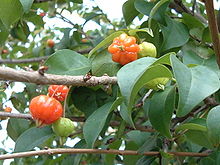Eugenia uniflora: Difference between revisions
No edit summary |
|||
| Line 29: | Line 29: | ||
[[Category:Trees of Brazil]] |
[[Category:Trees of Brazil]] |
||
[[Category:Fruit]] |
[[Category:Fruit]] |
||
[[Category:Flora of Angola]] |
|||
[[Category:Fruits of Angola]] |
|||
{{Myrtaceae-stub}} |
{{Myrtaceae-stub}} |
||
Revision as of 17:25, 4 September 2008
| Surinam Cherry | |
|---|---|

| |
| Scientific classification | |
| Kingdom: | |
| (unranked): | |
| (unranked): | |
| (unranked): | |
| Order: | |
| Family: | |
| Genus: | |
| Species: | E. uniflora
|
| Binomial name | |
| Eugenia uniflora | |
The Surinam Cherry, Brazilian Cherry, or Cayenne Cherry (Eugenia uniflora) is a plant in the family Myrtaceae, native to tropical America. Known as Pitanga throughout Brazil, it is a large shrub or small tree with a conical form, growing slowly to 8 meters in height. The leaves are glossy green, up to 4 cm long, and new leaves are copper-colored. Fragrant white flowers mature into reddish fruits up to 2 cm in diameter. The flavor ranges from sweet to sour, depending on the cultivar and level of ripeness (the darker red to black range is quite sweet, while the green to orange range is strikingly tart). The Surinam Cherry is often used in gardens as a hedge or screen. The fruit is high in Vitamin C, and its predominant food use is as a flavoring and base for jams and jellies. The tree was introduced to Bermuda for ornamental purposes but has gotten out of control and is now listed as invasive in Bermuda.
For Brazilian Cherry also see Jatobá.
External links
-
Eugenia uniflora
-
Eugenia uniflora


